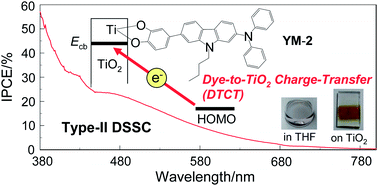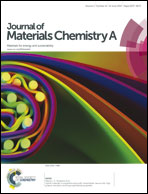Development of D–π–Cat fluorescent dyes with a catechol group for dye-sensitized solar cells based on dye-to-TiO2 charge transfer
Abstract
D–π–Cat fluorescent dyes YM-1 and YM-2 with a diphenylamine moiety as the electron-donating group, a catechol (Cat) unit as the anchoring group and fluorene or carbazole as the π-conjugated system were designed and developed as a photosensitizer for type-II dye-sensitized solar cells (DSSCs), which have a direct electron-injection pathway from the dye to the conduction band (CB) of the TiO2 electrode by photoexcitation of the dye-to-TiO2 charge transfer (DTCT) bands. Furthermore, not only to gain insight into the influence of the molecular structure of D–π–Cat dyes on the appearance of a DTCT band and the electron-injection mechanism, but also to investigate the impacts of the DTCT characteristics of D–π–Cat dyes on the photovoltaic performances of DSSCs, a D–π–Cat fluorescent dye YM-3 with carbazole–terthiophene as the π-conjugated system was also synthesized. It was found that the D–π–Cat dyes possess a good light-harvesting efficiency (LHE) in the visible region due to a broad absorption band corresponding to DTCT upon binding to a TiO2 film. The incident photon-to-current conversion efficiency (IPCE) corresponding to the DTCT band for DSSCs based on YM-1 and YM-2 is higher than that for YM-3. This work indicates that the stabilization of the LUMO level and the expansion of the π-conjugated system by the introduction of a long π-bridge such as terthiophene on the Cat moiety can lead to an increase in the intramolecular charge transfer (ICT) excitation based on π → π* transition with a decrease in the DTCT characteristics, resulting in enhancement of an indirect electron-injection pathway from the excited dye to the CB of TiO2 by photoexcitation of the local band of the adsorbed dye on TiO2.


 Please wait while we load your content...
Please wait while we load your content...